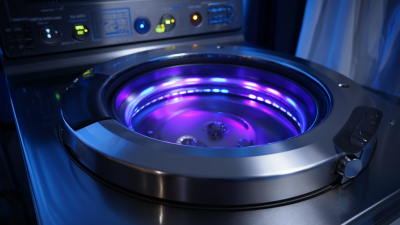Optimizing Clinical Results with the Latest Low Sample Volume Analyzer Technology
Table of Contents
- Understanding Low Sample Volume Analyzer Technology in Clinical Settings
- Key Benefits of Low Sample Volume Analyzers for Laboratory Efficiency
- Step-by-Step Implementation of Low Sample Volume Analyzers
- Best Practices for Optimizing Clinical Outcomes with New Technology
- Evaluating Clinical Results: Metrics and Impact of Low Sample Analyzers
- FAQS
- Conclusion
- Related Posts
You know, these days, everyone’s talking about how crucial it is to have reliable diagnostic tools in healthcare. The truth is, there’s a real push for smarter tech that can give accurate results, even when they don’t have a lot of sample to work with. I read somewhere that the global market for point-of-care testing is expected to hit around $34.5 billion by 2025 — pretty impressive, right? That’s mainly because there’s a big demand for quick, on-the-spot diagnostics. In the midst of all that, Low Sample Volume Analyzers are really making waves. They’re changing the game by cutting down on the amount of sample needed, all while boosting testing efficiency.

A company like Zhejiang Pushkang Biotechnology, founded back in 2014, has really stepped up in this space. They’re using cutting-edge centrifugal microfluidics technology to develop all sorts of point-of-care testing devices — from coagulation and biochemistry to CLIA and molecular tests. Thanks to these new analyzers, Pushkang is aiming to shake up how we approach patient care, making it better and faster in this fast-changing healthcare world.
Understanding Low Sample Volume Analyzer Technology in Clinical Settings
You know, Low Sample Volume (LSV) Analyzer Technology is really changing the game in healthcare. It’s making testing quicker and more accurate, all while needing only a tiny sample, which is a huge win—especially in places like neonatology and pediatrics, where grabbing enough sample can be a real pain.
I read somewhere that the global market for these analyzers is set to hit around USD 1.2 billion by 2025, mainly because the tech keeps improving and there's a growing need for speedy diagnostics. That’s pretty exciting, right?
What’s also cool is that LSV analyzers can handle a bunch of tests at once without sacrificing accuracy. According to a study in the Journal of Clinical Pathology, they boost testing efficiency by about 20%, meaning results come back faster. Plus, because they use less sample and reduce contamination or dilution errors, you can trust the results more. As healthcare shifts towards personalized medicine and point-of-care testing, it’s clear that understanding and using LSV analyzer technology is going to be super important for giving patients better care and more reliable diagnostics.
Key Benefits of Low Sample Volume Analyzers for Laboratory Efficiency
 Low sample volume analyzers have really started making a big splash in labs these days, especially for those looking to boost efficiency without sacrificing accuracy when it comes to clinical results. The cool thing is, these machines only need a tiny bit of blood or sample — which is a huge plus if you're working with kiddos or elderly patients who might have very limited blood volume. By cutting down the amount needed, labs can squeeze in more tests, cut down on supplies, and keep things running smoothly without wasting resources.
Low sample volume analyzers have really started making a big splash in labs these days, especially for those looking to boost efficiency without sacrificing accuracy when it comes to clinical results. The cool thing is, these machines only need a tiny bit of blood or sample — which is a huge plus if you're working with kiddos or elderly patients who might have very limited blood volume. By cutting down the amount needed, labs can squeeze in more tests, cut down on supplies, and keep things running smoothly without wasting resources.
Plus, one of the best parts is how much faster they can get results back to healthcare providers. Smaller samples mean quicker processing times, so doctors don't have to wait around long to make decisions. They also come packed with fancy new tech that makes tests more precise and reliable—reducing the chances of getting false positives or negatives.
If your lab is thinking about jumping on the bandwagon, it’s a good idea to review your current testing processes to see where these analyzers could help speed things up or smooth things out. Making sure staff are properly trained on how to use the new equipment is super important—this way, you actually get accurate results and get the most out of your investment. And don’t forget, working closely with the manufacturer can help tailor these machines to fit your specific needs, which ultimately means better patient care and more efficient operations all around.
Step-by-Step Implementation of Low Sample Volume Analyzers
Bringing in low sample volume analyzers in clinical settings really has the potential to make diagnosing stuff quicker and help patients get better care faster. If you take it one step at a time, healthcare providers can smoothly add these cool new tools into their daily routines. First off, it’s super important to assess what the lab actually needs — you want to pick an analyzer that fits the kinds of tests you're doing, whether it’s coagulation or molecular diagnostics. Taking that little extra moment to choose wisely can really pay off, helping you get the most out of low sample volume tech.
Here at Zhejiang Pushkang Biotechnology Co., Ltd., we genuinely believe in how game-changing this technology can be, especially in in vitro diagnostics. We started back in 2014, and our team’s been working on cutting-edge POCT products using centrifugal microfluidics so labs of all kinds can meet their diagnostic needs. We work closely with healthcare facilities when they’re adopting our tools — making sure everything goes smoothly and that they get personalized support. That way, switching to lower sample volumes becomes a breeze, saving resources, speeding up results, and ultimately helping doctors make better decisions for their patients.
Optimizing Clinical Results with Low Sample Volume Analyzers
This chart illustrates the efficiency of clinical results achieved using low sample volume analyzers over a span of time.
Best Practices for Optimizing Clinical Outcomes with New Technology
Bringing low sample volume analyzers into clinical settings has really opened up some exciting possibilities for improving patient care. Because these devices need only a tiny amount of sample, they make better use of precious biological material and help deliver faster results—something that can be a game-changer when quick diagnosis is crucial. Of course, to get the most out of these tools, healthcare providers should make a habit of routine calibration and maintenance. That way, they can trust the results and make confident clinical decisions.
It’s also super important to train the staff properly—understanding what these analyzers can and can’t do helps avoid mistakes and ensures the results are spot on. Clear protocols for use and interpretation are key. Plus, teamwork really matters here—laboratory techs, doctors, and IT folks should work together to maximize these tools’ potential. Keeping everyone in the loop with regular feedback and staying updated on the latest tech advancements really helps healthcare systems adapt and keep delivering top-notch care. At the end of the day, all these efforts mean patients get better, faster testing without sacrificing accuracy.

Evaluating Clinical Results: Metrics and Impact of Low Sample Analyzers
The emergence of low sample volume (LSV) analyzers has really shaken things up in clinical diagnostics. Honestly, they’ve made it way easier for us to get accurate results without needing a ton of blood or samples. That’s a big deal, especially when testing patients like newborns or older folks, where drawing a lot of blood isn’t ideal. Thanks to their precision, healthcare providers can keep tabs on different health markers pretty efficiently, which means quicker interventions and hopefully better outcomes for patients.
Heads-up: When you’re putting LSV analyzers into your workflow, it’s a good idea to double-check how they stack up against the traditional methods you’re used to. This way, you’ll know your results are just as reliable, if not more so.
But it’s not just about saving sample volume — LSV tech really streamlines the whole clinical process. Labs can run more tests in less time, so doctors get results faster, and treatment can start sooner. In a healthcare world that’s all about putting patients first, these analyzers are becoming an essential tool in meeting the need for both speed and accuracy.
Pro tip: Make it a habit to review how patients are doing based on the LSV test results. Tracking these outcomes can give you valuable insights into how well the technology is working and help you fine-tune your processes moving forward.
Optimizing Clinical Results with the Latest Low Sample Volume Analyzer Technology - Evaluating Clinical Results: Metrics and Impact of Low Sample Analyzers
| Analyzer Type | Sample Volume (µL) | Turnaround Time (Minutes) | Accuracy (%) | Precision (CV%) | Clinical Impact Score |
|---|---|---|---|---|---|
| Type A Analyzer | 15 | 12 | 98.5 | 3.2 | 9.8 |
| Type B Analyzer | 10 | 10 | 97.8 | 2.8 | 8.7 |
| Type C Analyzer | 20 | 15 | 99.0 | 3.0 | 9.5 |
FAQS
nalyzer Technology?
The global market for LSV analyzers is expected to reach USD 1.2 billion by 2025, due to advancements in technology and an increasing demand for rapid diagnostic methods.
LSV analyzers have demonstrated a 20% increase in testing efficiency, significantly reducing turnaround time for results without compromising accuracy.
LSV technology minimizes the risk of sample contamination and dilution errors, enhancing the reliability of diagnostic outcomes and optimizing patient care.
The initial step is to evaluate the specific needs of the laboratory to ensure the selected analyzer aligns with the types of tests conducted.
By adopting a thoughtful selection process for analyzers that fits their diagnostic requirements, facilities can maximize the benefits of low sample volume technology.
Zhejiang Pushkang Biotechnology Co., Ltd. develops cutting-edge point-of-care testing (POCT) products using centrifugal microfluidics and provides tailored support to healthcare facilities during implementation.
LSV technology supports the movement towards personalized medicine and point-of-care testing, which is essential for optimizing clinical results and improving patient care.
The implementation of LSV analyzers contributes to better clinical outcomes for patients, by providing rapid and accurate test results.
LSV technology addresses challenges related to traditional volume requirements for tests, especially in neonatology and pediatrics, where obtaining sufficient samples can be difficult.
Conclusion
So, I recently came across this article titled "Optimizing Clinical Results with the Latest Low Sample Volume Analyzer Technology," and honestly, it’s pretty eye-opening about how much these analyzers are revolutionizing labs today. It kicks off by diving into what these machines actually do and the cool benefits they bring—like making lab work way more efficient, which is a huge plus. The article also walks you through how to smoothly adopt these analyzers step-by-step, sharing some solid tips for healthcare folks looking to get better clinical results. Oh, and it doesn't forget to highlight the key metrics to watch when assessing the impact of this tech in real-world scenarios.
On a related note, Zhejiang Pushkang Biotechnology, which started back in 2014, has really been leading the way when it comes to bringing Low Sample Volume Analyzer tech into in-vitro diagnostics. They’ve got some serious expertise in centrifugal microfluidics, which has helped them develop smart, point-of-care testing solutions. Basically, this means healthcare providers can get accurate, quick diagnoses without wasting valuable resources—super important in today’s busy clinical environments.
Related Posts
-

How to Locate the Best Quest Near Me for an Unforgettable Adventure
-

How to Harness Whole Blood Plasma for Enhanced Healing and Recovery with Recent Scientific Findings
-

5 Key Reasons Veterinary Care is Essential for Your Pet's Health and Wellbeing
-

What is the Significance of Centrifuging Examples in Modern Industry
-

Centrifuge Drawing Market Trends and Insights from 2025 China 138th Import and Export Fair
-

Mastering the Rcf Centrifuge A Step by Step Tutorial for Optimal Performance

